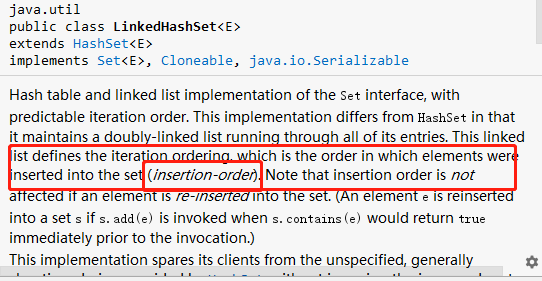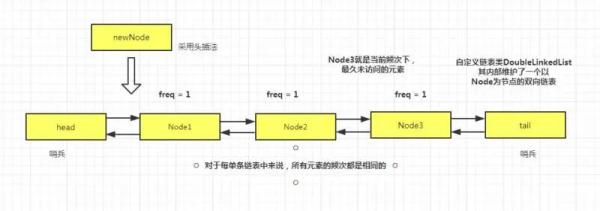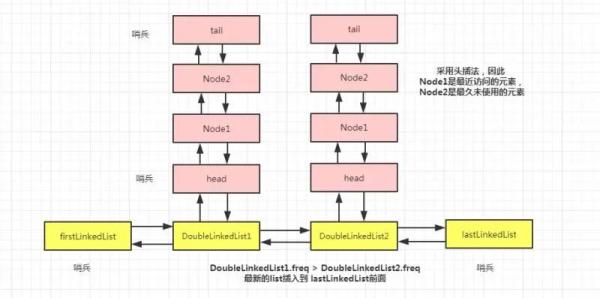本篇内容主要讲解“有哪些LFU实现方式”,感兴趣的朋友不妨来看看。本文介绍的方法操作简单快捷,实用性强。下面就让小编来带大家学习“有哪些LFU实现方式”吧!
LFU实现
力扣原题描述如下:
请你为 最不经常使用(LFU)缓存算法设计并实现数据结构。它应该支持以下操作:get 和 put。 get(key) - 如果键存在于缓存中,则获取键的值(总是正数),否则返回 -1。 put(key, value) - 如果键不存在,请设置或插入值。当缓存达到其容量时,则应该在插入新项之前,使最不经常使用的项无效。在此问题中,当存在平局(即两个或更多个键具有相同使用频率)时,应该去除 最近 最少使用的键。 「项的使用次数」就是自插入该项以来对其调用 get 和 put 函数的次数之和。使用次数会在对应项被移除后置为 0 。 示例: LFUCache cache = new LFUCache( 2 /* capacity (缓存容量) */ ); cache.put(1, 1); cache.put(2, 2); cache.get(1); // 返回 1 cache.put(3, 3); // 去除 key 2 cache.get(2); // 返回 -1 (未找到key 2) cache.get(3); // 返回 3 cache.put(4, 4); // 去除 key 1 cache.get(1); // 返回 -1 (未找到 key 1) cache.get(3); // 返回 3 cache.get(4); // 返回 4 来源:力扣(LeetCode) 链接:https://leetcode-cn.com/problems/lfu-cache
就是要求我们设计一个 LFU 算法,根据访问次数(访问频次)大小来判断应该删除哪个元素,get和put操作都会增加访问频次。当访问频次相等时,就判断哪个元素是最久未使用过的,把它删除。
因此,这道题需要考虑两个方面,一个是访问频次,一个是访问时间的先后顺序。
方案一:使用优先队列思路:
我们可以使用JDK提供的优先队列 PriorityQueue 来实现 。因为优先队列内部维护了一个二叉堆,即可以保证每次 poll 元素的时候,都可以根据我们的要求,取出当前所有元素的最大值或是最小值。只需要我们的实体类实现 Comparable 接口就可以了。
因此,我们需要定义一个 Node 来保存当前元素的访问频次 freq,全局的自增的 index,用于比较大小。然后定义一个 Map
当 cache 容量不足时,根据访问频次 freq 的大小来删除最小的 freq 。若相等,则删除 index 最小的,因为index是自增的,越大说明越是最近访问过的,越小说明越是很长时间没访问过的元素。
因本质是用二叉堆实现,故时间复杂度为O(logn)。
public class LFUCache4 { public static void main(String[] args) { LFUCache4 cache = new LFUCache4(2); cache.put(1, 1); cache.put(2, 2); // 返回 1 System.out.println(cache.get(1)); cache.put(3, 3); // 去除 key 2 // 返回 -1 (未找到key 2) System.out.println(cache.get(2)); // 返回 3 System.out.println(cache.get(3)); cache.put(4, 4); // 去除 key 1 // 返回 -1 (未找到 key 1) System.out.println(cache.get(1)); // 返回 3 System.out.println(cache.get(3)); // 返回 4 System.out.println(cache.get(4)); } //缓存了所有元素的node Map<Integer,Node> cache; //优先队列 Queue<Node> queue; //缓存cache 的容量 int capacity; //当前缓存的元素个数 int size; //全局自增 int index = 0; //初始化 public LFUCache4(int capacity){ this.capacity = capacity; if(capacity > 0){ queue = new PriorityQueue<>(capacity); } cache = new HashMap<>(); } public int get(int key){ Node node = cache.get(key); // node不存在,则返回 -1 if(node == null) return -1; //每访问一次,频次和全局index都自增 1 node.freq++; node.index = index++; // 每次都重新remove,再offer是为了让优先队列能够对当前Node重排序 //不然的话,比较的 freq 和 index 就是不准确的 queue.remove(node); queue.offer(node); return node.value; } public void put(int key, int value){ //容量0,则直接返回 if(capacity == 0) return; Node node = cache.get(key); //如果node存在,则更新它的value值 if(node != null){ node.value = value; node.freq++; node.index = index++; queue.remove(node); queue.offer(node); }else { //如果cache满了,则从优先队列中取出一个元素,这个元素一定是频次最小,最久未访问过的元素 if(size == capacity){ cache.remove(queue.poll().key); //取出元素后,size减 1 size--; } //否则,说明可以添加元素,于是创建一个新的node,添加到优先队列中 Node newNode = new Node(key, value, index++); queue.offer(newNode); cache.put(key,newNode); //同时,size加 1 size++; } } //必须实现 Comparable 接口才可用于排序 private class Node implements Comparable<Node>{ int key; int value; int freq = 1; int index; public Node(){ } public Node(int key, int value, int index){ this.key = key; this.value = value; this.index = index; } @Override public int compareTo(Node o) { //优先比较频次 freq,频次相同再比较index int minus = this.freq - o.freq; return minus == 0? this.index - o.index : minus; } } }方案二:使用一条双向链表
思路:
只用一条双向链表,来维护频次和时间先后顺序。那么,可以这样想。把频次 freq 小的放前面,频次大的放后面。如果频次相等,就从当前节点往后遍历,直到找到第一个频次比它大的元素,并插入到它前面。(当然,如果遍历到了tail,则插入到tail前面)这样可以保证同频次的元素,最近访问的总是在最后边。
因此,总的来说,最低频次,并且最久未访问的元素肯定就是链表中最前面的那一个了。这样的话,当 cache容量满的时候,直接把头结点删除掉就可以了。但是,我们这里为了方便链表的插入和删除操作,用了两个哨兵节点,来表示头节点 head和尾结点tail。因此,删除头结点就相当于删除 head.next。
PS:哨兵节点只是为了占位,实际并不存储有效数据,只是为了链表插入和删除时,不用再判断当前节点的位置。不然的话,若当前节点占据了头结点或尾结点的位置,还需要重新赋值头尾节点元素,较麻烦。
为了便于理解新节点如何插入到链表中合适的位置,作图如下:

代码如下:
public class LFUCache { public static void main(String[] args) { LFUCache cache = new LFUCache(2); cache.put(1, 1); cache.put(2, 2); // 返回 1 System.out.println(cache.get(1)); cache.put(3, 3); // 去除 key 2 // 返回 -1 (未找到key 2) System.out.println(cache.get(2)); // 返回 3 System.out.println(cache.get(3)); cache.put(4, 4); // 去除 key 1 // 返回 -1 (未找到 key 1) System.out.println(cache.get(1)); // 返回 3 System.out.println(cache.get(3)); // 返回 4 System.out.println(cache.get(4)); } private Map<Integer,Node> cache; private Node head; private Node tail; private int capacity; private int size; public LFUCache(int capacity) { this.capacity = capacity; this.cache = new HashMap<>(); /** * 初始化头结点和尾结点,并作为哨兵节点 */ head = new Node(); tail = new Node(); head.next = tail; tail.pre = head; } public int get(int key) { Node node = cache.get(key); if(node == null) return -1; node.freq++; moveToPostion(node); return node.value; } public void put(int key, int value) { if(capacity == 0) return; Node node = cache.get(key); if(node != null){ node.value = value; node.freq++; moveToPostion(node); }else{ //如果元素满了 if(size == capacity){ //直接移除最前面的元素,因为这个节点就是频次最小,且最久未访问的节点 cache.remove(head.next.key); removeNode(head.next); size--; } Node newNode = new Node(key, value); //把新元素添加进来 addNode(newNode); cache.put(key,newNode); size++; } } //只要当前 node 的频次大于等于它后边的节点,就一直向后找, // 直到找到第一个比当前node频次大的节点,或者tail节点,然后插入到它前面 private void moveToPostion(Node node){ Node nextNode = node.next; //先把当前元素删除 removeNode(node); //遍历到符合要求的节点 while (node.freq >= nextNode.freq && nextNode != tail){ nextNode = nextNode.next; } //把当前元素插入到nextNode前面 node.pre = nextNode.pre; node.next = nextNode; nextNode.pre.next = node; nextNode.pre = node; } //添加元素(头插法),并移动到合适的位置 private void addNode(Node node){ node.pre = head; node.next = head.next; head.next.pre = node; head.next = node; moveToPostion(node); } //移除元素 private void removeNode(Node node){ node.pre.next = node.next; node.next.pre = node.pre; } class Node { int key; int value; int freq = 1; //当前节点的前一个节点 Node pre; //当前节点的后一个节点 Node next; public Node(){ } public Node(int key ,int value){ this.key = key; this.value = value; } } }可以看到不管是插入元素还是删除元素时,都不需要额外的判断,这就是设置哨兵节点的好处。
由于每次访问元素的时候,都需要按一定的规则把元素放置到合适的位置,因此,元素需要从前往后一直遍历。所以,时间复杂度 O(n)。
方案三:用 LinkedHashSet维护频次链表
思路:
我们不再使用一条链表,同时维护频次和访问时间了。此处,换为用 map 键值对来维护,用频次作为键,用当前频次对应的一条具有先后访问顺序的链表来作为值。它的结构如下:
Map<Integer, LinkedHashSet<Node>> freqMap

由于LinkedHashSet 的 iterator迭代方法是按插入顺序的,因此迭代到的第一个元素肯定是当前频次下,最久未访问的元素。这样的话,当缓存 cache满的时候,直接删除迭代到的第一个元素就可以了。
另外 freqMap,也需要在每次访问元素的时候,重新维护关系。从当前元素的频次对应的双向链表中移除当前元素,并加入到高频次的链表中。
public class LFUCache1 { public static void main(String[] args) { LFUCache1 cache = new LFUCache1(2); cache.put(1, 1); cache.put(2, 2); // 返回 1 System.out.println(cache.get(1)); cache.put(3, 3); // 去除 key 2 // 返回 -1 (未找到key 2) System.out.println(cache.get(2)); // 返回 3 System.out.println(cache.get(3)); cache.put(4, 4); // 去除 key 1 // 返回 -1 (未找到 key 1) System.out.println(cache.get(1)); // 返回 3 System.out.println(cache.get(3)); // 返回 4 System.out.println(cache.get(4)); } //缓存 cache private Map<Integer,Node> cache; //存储频次和对应双向链表关系的map private Map<Integer, LinkedHashSet<Node>> freqMap; private int capacity; private int size; //存储最小频次值 private int min; public LFUCache1(int capacity) { this.capacity = capacity; cache = new HashMap<>(); freqMap = new HashMap<>(); } public int get(int key) { Node node = cache.get(key); if(node == null) return -1; //若找到当前元素,则频次加1 freqInc(node); return node.value; } public void put(int key, int value) { if(capacity == 0) return; Node node = cache.get(key); if(node != null){ node.value = value; freqInc(node); }else{ if(size == capacity){ Node deadNode = removeNode(); cache.remove(deadNode.key); size --; } Node newNode = new Node(key,value); cache.put(key,newNode); addNode(newNode); size++; } } //处理频次map private void freqInc(Node node){ //从原来的频次对应的链表中删除当前node LinkedHashSet<Node> set = freqMap.get(node.freq); if(set != null) set.remove(node); //如果当前频次是最小频次,并且移除元素后,链表为空,则更新min值 if(node.freq == min && set.size() == 0){ min = node.freq + 1; } //添加到新的频次对应的链表 node.freq ++; LinkedHashSet<Node> newSet = freqMap.get(node.freq); //如果高频次链表还未存在,则初始化一条 if(newSet == null){ newSet = new LinkedHashSet<Node>(); freqMap.put(node.freq,newSet); } newSet.add(node); } //添加元素,更新频次 private void addNode(Node node){ //添加新元素,肯定是需要加入到频次为1的链表中的 LinkedHashSet<Node> set = freqMap.get(1); if(set == null){ set = new LinkedHashSet<>(); freqMap.put(1,set); } set.add(node); //更新最小频次为1 min = 1; } //删除频次最小,最久未访问的元素 private Node removeNode(){ //找到最小频次对应的 LinkedHashSet LinkedHashSet<Node> set = freqMap.get(min); //迭代到的第一个元素就是最久未访问的元素,移除之 Node node = set.iterator().next(); set.remove(node); //如果当前node的频次等于最小频次,并且移除元素之后,set为空,则 min 加1 if(node.freq == min && set.size() == 0){ min ++; } return node; } private class Node { int key; int value; int freq = 1; public Node(int key, int value){ this.key = key; this.value = value; } public Node(){ } } }方案四:手动实现一个频次链表
思路:
由于方案三用的是JDK自带的 LinkedHashSet ,其是实现了哈希表和双向链表的一个类,因此为了减少哈希相关的计算,提高效率,我们自己实现一条双向链表来替代它。
那么,这条双向链表,就需要维护当前频次下的所有元素的先后访问顺序。我们采用头插法,把新加入的元素添加到链表头部,这样的话,最久未访问的元素就在链表的尾部。
同样的,我们也用两个哨兵节点来代表头尾节点,以方便链表的操作。

代码如下:
public class LFUCache2 { public static void main(String[] args) { LFUCache2 cache = new LFUCache2(2); cache.put(1, 1); cache.put(2, 2); // 返回 1 System.out.println(cache.get(1)); cache.put(3, 3); // 去除 key 2 // 返回 -1 (未找到key 2) System.out.println(cache.get(2)); // 返回 3 System.out.println(cache.get(3)); cache.put(4, 4); // 去除 key 1 // 返回 -1 (未找到 key 1) System.out.println(cache.get(1)); // 返回 3 System.out.println(cache.get(3)); // 返回 4 System.out.println(cache.get(4)); } private Map<Integer,Node> cache; private Map<Integer,DoubleLinkedList> freqMap; private int capacity; private int size; private int min; public LFUCache2(int capacity){ this.capacity = capacity; cache = new HashMap<>(); freqMap = new HashMap<>(); } public int get(int key){ Node node = cache.get(key); if(node == null) return -1; freqInc(node); return node.value; } public void put(int key, int value){ if(capacity == 0) return; Node node = cache.get(key); if(node != null){ node.value = value; //更新value值 freqInc(node); }else{ //若size达到最大值,则移除频次最小,最久未访问的元素 if(size == capacity){ //因链表是头插法,所以尾结点的前一个节点就是最久未访问的元素 DoubleLinkedList list = freqMap.get(min); //需要移除的节点 Node deadNode = list.tail.pre; cache.remove(deadNode.key); list.removeNode(deadNode); size--; } //新建一个node,并把node放到频次为 1 的 list 里面 Node newNode = new Node(key,value); DoubleLinkedList newList = freqMap.get(1); if(newList == null){ newList = new DoubleLinkedList(); freqMap.put(1,newList); } newList.addNode(newNode); cache.put(key,newNode); size++; min = 1;//此时需要把min值重新设置为1 } } //修改频次 private void freqInc(Node node){ //先删除node对应的频次list DoubleLinkedList list = freqMap.get(node.freq); if(list != null){ list.removeNode(node); } //判断min是否等于当前node的频次,且当前频次的list为空,是的话更新min值 if(min == node.freq && list.isEmpty()){ min ++; } //然后把node频次加 1,并把它放到高频次list node.freq ++; DoubleLinkedList newList = freqMap.get(node.freq); if(newList == null){ newList = new DoubleLinkedList(); freqMap.put(node.freq, newList); } newList.addNode(node); } private class Node { int key; int value; int freq = 1; Node pre; Node next; public Node(){ } public Node(int key, int value){ this.key = key; this.value = value; } } //自实现的一个双向链表 private class DoubleLinkedList { Node head; Node tail; // 设置两个哨兵节点,作为头、尾节点便于插入和删除操作 public DoubleLinkedList(){ head = new Node(); tail = new Node(); head.next = tail; tail.pre = head; } //采用头插法,每次都插入到链表的最前面,即 head 节点后边 public void addNode(Node node){ node.pre = head; node.next = head.next; //注意先把head的后节点的前节点设置为node head.next.pre = node; head.next = node; } //删除元素 public void removeNode(Node node){ node.pre.next = node.next; node.next.pre = node.pre; } //判断是否为空,即是否存在除了哨兵节点外的有效节点 public boolean isEmpty(){ //判断头结点的下一个节点是否是尾结点,是的话即为空 return head.next == tail; } } }方案五:用双向链表嵌套
思路:
可以发现方案三和方案四,都是用 freqmap 来存储频次和它对应的链表之间的关系,它本身也是一个哈希表。这次,我们完全用自己实现的双向链表来代替 freqMap,进一步提高效率。
但是,结构有些复杂,它是一个双向链表中,每个元素又是双向链表。为了便于理解,我把它的结构作图如下:(为了方便,分别叫做外层链表,内层链表)

我们把整体看成一个由 DoubleLinkedList组成的双向链表,然后,每一个 DoubleLinkedList 对象中又是一个由 Node 组成的双向链表。像极了 HashMap 数组加链表的形式。
但是,我们这里没有数组,也就不存在哈希碰撞的问题。并且都是双向链表,都有哨兵存在,便于灵活的从链表头部或者尾部开始操作元素。
这里,firstLinkedList 和 lastLinkedList 分别代表外层链表的头尾结点。链表中的元素 DoubleLinkedList 有一个字段 freq 记录了频次,并且按照前大后小的顺序组成外层链表,即图中的 DoubleLinkedList1.freq 大于它后面的 DoubleLinkedList2.freq。
每当有新频次的 DoubleLinkedList 需要添加进来的时候,直接插入到 lastLinkedList 这个哨兵前面,因此 lastLinkedList.pre 就是一个最小频次的内部链表。
内部链表中是由 Node组成的双向链表,也有两个哨兵代表头尾节点,并采用头插法。其实,可以看到内部链表和方案四,图中所示的双向链表结构是一样的,不用多说了。
这样的话,我们就可以找到频次最小,并且最久未访问的元素,即
//频次最小,最久未访问的元素,cache满时需要删除 lastLinkedList.pre.tail.pre
于是,代码就好理解了:
public class LFUCache3 { public static void main(String[] args) { LFUCache3 cache = new LFUCache3(2); cache.put(1, 1); cache.put(2, 2); // 返回 1 System.out.println(cache.get(1)); cache.put(3, 3); // 去除 key 2 // 返回 -1 (未找到key 2) System.out.println(cache.get(2)); // 返回 3 System.out.println(cache.get(3)); cache.put(4, 4); // 去除 key 1 // 返回 -1 (未找到 key 1) System.out.println(cache.get(1)); // 返回 3 System.out.println(cache.get(3)); // 返回 4 System.out.println(cache.get(4)); } Map<Integer,Node> cache; /** * 这两个代表的是以 DoubleLinkedList 连接成的双向链表的头尾节点, * 且为哨兵节点。每个list中,又包含一个由 node 组成的一个双向链表。 * 最外层双向链表中,freq 频次较大的 list 在前面,较小的 list 在后面 */ DoubleLinkedList firstLinkedList, lastLinkedList; int capacity; int size; public LFUCache3(int capacity){ this.capacity = capacity; cache = new HashMap<>(); //初始化外层链表的头尾节点,作为哨兵节点 firstLinkedList = new DoubleLinkedList(); lastLinkedList = new DoubleLinkedList(); firstLinkedList.next = lastLinkedList; lastLinkedList.pre = firstLinkedList; } //存储具体键值对信息的node private class Node { int key; int value; int freq = 1; Node pre; Node next; DoubleLinkedList doubleLinkedList; public Node(){ } public Node(int key, int value){ this.key = key; this.value = value; } } public int get(int key){ Node node = cache.get(key); if(node == null) return -1; freqInc(node); return node.value; } public void put(int key, int value){ if(capacity == 0) return; Node node = cache.get(key); if(node != null){ node.value = value; freqInc(node); }else{ if(size == capacity){ /** * 如果满了,则需要把频次最小的,且最久未访问的节点删除 * 由于list组成的链表频次从前往后依次减小,故最小的频次list是 lastLinkedList.pre * list中的双向node链表采用的是头插法,因此最久未访问的元素是 lastLinkedList.pre.tail.pre */ //最小频次list DoubleLinkedList list = lastLinkedList.pre; //最久未访问的元素,需要删除 Node deadNode = list.tail.pre; cache.remove(deadNode.key); list.removeNode(deadNode); size--; //如果删除deadNode之后,此list中的双向链表空了,则删除此list if(list.isEmpty()){ removeDoubleLinkedList(list); } } //没有满,则新建一个node Node newNode = new Node(key, value); cache.put(key,newNode); //判断频次为1的list是否存在,不存在则新建 DoubleLinkedList list = lastLinkedList.pre; if(list.freq != 1){ DoubleLinkedList newList = new DoubleLinkedList(1); addDoubleLinkedList(newList,list); newList.addNode(newNode); }else{ list.addNode(newNode); } size++; } } //修改频次 private void freqInc(Node node){ //从当前频次的list中移除当前 node DoubleLinkedList list = node.doubleLinkedList; if(list != null){ list.removeNode(node); } //如果当前list中的双向node链表空,则删除此list if(list.isEmpty()){ removeDoubleLinkedList(list); } //当前node频次加1 node.freq++; //找到当前list前面的list,并把当前node加入进去 DoubleLinkedList preList = list.pre; //如果前面的list不存在,则新建一个,并插入到由list组成的双向链表中 //前list的频次不等于当前node频次,则说明不存在 if(preList.freq != node.freq){ DoubleLinkedList newList = new DoubleLinkedList(node.freq); addDoubleLinkedList(newList,preList); newList.addNode(node); }else{ preList.addNode(node); } } //从外层双向链表中删除当前list节点 public void removeDoubleLinkedList(DoubleLinkedList list){ list.pre.next = list.next; list.next.pre = list.pre; } //知道了它的前节点,即可把新的list节点插入到其后面 public void addDoubleLinkedList(DoubleLinkedList newList, DoubleLinkedList preList){ newList.pre = preList; newList.next = preList.next; preList.next.pre = newList; preList.next = newList; } //维护一个双向DoubleLinkedList链表 + 双向Node链表的结构 private class DoubleLinkedList { //当前list中的双向Node链表所有频次都相同 int freq; //当前list中的双向Node链表的头结点 Node head; //当前list中的双向Node链表的尾结点 Node tail; //当前list的前一个list DoubleLinkedList pre; //当前list的后一个list DoubleLinkedList next; public DoubleLinkedList(){ //初始化内部链表的头尾节点,并作为哨兵节点 head = new Node(); tail = new Node(); head.next = tail; tail.pre = head; } public DoubleLinkedList(int freq){ head = new Node(); tail = new Node(); head.next = tail; tail.pre = head; this.freq = freq; } //删除当前list中的某个node节点 public void removeNode(Node node){ node.pre.next = node.next; node.next.pre = node.pre; } //头插法将新的node插入到当前list,并在新node中记录当前list的引用 public void addNode(Node node){ node.pre = head; node.next = head.next; head.next.pre = node; head.next = node; node.doubleLinkedList = this; } //当前list中的双向node链表是否存在有效节点 public boolean isEmpty(){ //只有头尾哨兵节点,则说明为空 return head.next == tail; } } }到此,相信大家对“有哪些LFU实现方式”有了更深的了解,不妨来实际操作一番吧!这里是亿速云网站,更多相关内容可以进入相关频道进行查询,关注我们,继续学习!
免责声明:本站发布的内容(图片、视频和文字)以原创、转载和分享为主,文章观点不代表本网站立场,如果涉及侵权请联系站长邮箱:is@yisu.com进行举报,并提供相关证据,一经查实,将立刻删除涉嫌侵权内容。